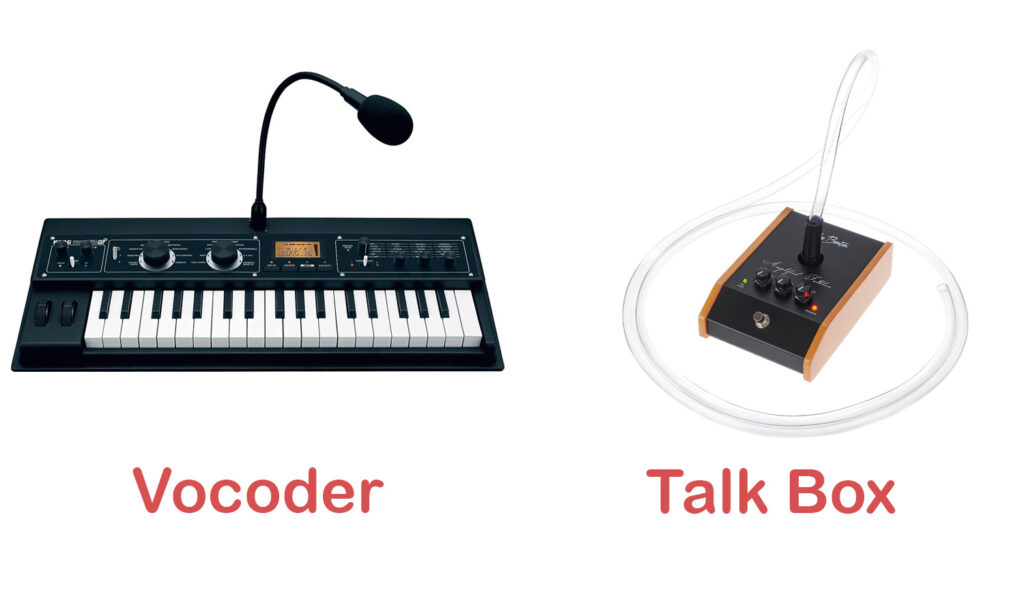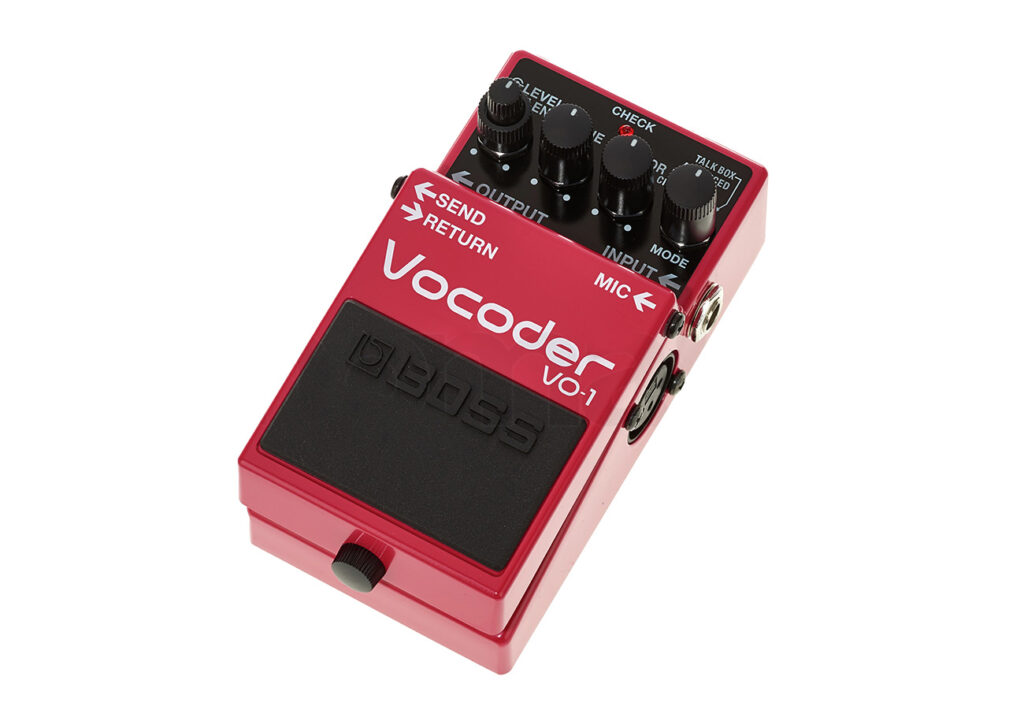What is a vocoder?
A vocoder (short for "voice encoder") is a device or software algorithm capable of analyzing and synthesizing the characteristic properties of a human voice (or other audio signal).
The result is a robotic, unnatural voice that can be appropriate for certain musical situations and genres. The sound of a vocoder is often referred to as a "talking synthesizer". This effect can be heard very well in the following video:

By loading the video, you accept YouTube's privacy policy.
Learn more
The vocoder was originally developed for military purposes in the 1930s to reduce the bandwidth of telephone transmissions. During World War II, it was used for encrypted voice communication - but the device became definitely more popular among musicians.
How does a vocoder work?
A vocoder manipulates the sound of a voice by breaking it down into its individual frequency bands and then using those bands to modulate another audio signal called the "carrier". This means that it takes the rhythmic and melodic characteristics of the original voice and transfers them to the carrier, resulting in a completely new sound.

There are essentially 3 main steps in the work of a vocoder:
- Analysis: The vocoder analyzes the "modulator" signal, usually a human voice, and splits it into different frequency bands. This decomposition is done to isolate the different characteristic frequencies of the voice (such as the formants characteristic of certain vowels).
- Modulation: The amplitudes (or volumes) of these frequency bands are then used to modulate the "carrier" (synthesizer) signal. The carrier can be any type of audio signal, often a synthesizer or musical instrument. Each frequency band of the carrier signal is amplified or attenuated according to the amplitude of the corresponding frequency band in the modulator signal.
- Synthesis: Finally, the carrier signal is output after passing through the various filters and modulators. In this way, the modulator signal (voice) has been mapped or "copied" onto the carrier signal (synthesizer). The synthesizer can then reproduce the human voice.
The result of these processes is an audio signal that has the rhythmic and melodic characteristics of the original voice - you can still understand the words and phrases - but has the sonic character of the carrier signal (a synthesizer). It can be perceived as a "sung" or "spoken" version of the carrier signal, often with a mechanical or "robotic" sound.
The tones are usually controlled by a keyboard, but you can also use MIDI to write the melody beforehand, so all you have to do is speak.
History
The vocoder was first experimented with and patented in 1928 by engineer Homer Dudley. It was used in the SIGSALY system for encrypted communication during World War II. Since the 1970s, most non-musical vocoders have been implemented using the Yule-Walker equation, which uses the all-pole IIR filter to process the signal.

In music, the vocoder first became popular in the 1970s. Wendy Carlos and Robert Moog developed one of the first musical vocoders in 1970. The carrier signal came from a Moog modular synthesizer, and the modulator came from a microphone. This vocoder was used in several recordings, including the soundtrack to Stanley Kubrick's film A Clockwork Orange. The first rock album to use a vocoder was Bruce Haack's The Electric Lucifer in 1970.
In the last decades, artists such as Daft Punk and Eiffel 65 have used the vocoder prominently in pop music. The vocoder sound has become a distinctive feature of the French electronic duo Daft Punk and the German band Kraftwerk.
A vocoder does not always need a human voice
The modulation signal doesn't always have to be a human voice - you can theoretically use any audio source. For example, you could use an electric guitar or a cello - but then the effect is not so blatant, because these audio sources are already more similar to the sound of a synthesizer. So the "transformation" is less noticeable.
Kraftwerk did not always use their own voice in the vocoder, but sometimes also the voice of a medical speech computer (which is actually meant for people who cannot speak). The result was a very robotic voice that sounded very futuristic.
Design of a vocoder
The classic vocoder looks like a synthesizer, which it is. The big difference is that the vocoder has a microphone, called a gooseneck microphone. This allows the musician to speak while playing the keyboard to control the pitch. In most cases, the keyboard is built into the device.
Modern vocoders are also available as DAW plugins. Then all you have to do is connect a microphone to the audio interface, select the appropriate input as the audio source, and you're ready to go.
The iZotope VocalSynth 2 or the Waves Morphoder are popular vocoder plugins that are definitely worth checking out.
There are two legendary vocoders that have been used extensively throughout music history and cost a fortune today: the Korg VC-10 (about $2000) and the Roland VP-33 (about $4000). Due to their fame and the fact that they are no longer in production, their prices have skyrocketed. Both have the characteristic design of a vocoder with keyboard, microphone and synthesizer parameters.
Vocoder vs Talkbox
Although vocoders and talkboxes are often used in the music industry to create similar effects, they work in very different ways.

A vocoder, as we have seen, combines or "encodes" two signals, usually a human voice (the modulator) and a musical instrument, often a synthesizer (the carrier). The device analyzes the spectral characteristics of the modulator and applies them to the carrier.
A talkbox works a little differently. It channels the sound of an instrument, usually a guitar or synthesizer, through a tube that the musician puts in his or her mouth. The musician's lips and mouth then shape the sound, while a microphone picks up the resulting sounds. The Talkbox uses the musician's mouth as a "formant filter" to change the sound of the instrument.

By loading the video, you accept YouTube's privacy policy.
Learn more
So we can say that a vocoder transfers the sound spectrum of a voice to another signal, while a talkbox shapes the timbre of an instrument with the articulation of a singer. Therefore, a vocoder can usually play several notes or chords at the same time (polyphonic), while a talkbox can usually play only one sound signal (monophonic), because the human voice can only articulate one note at a time.
Best Vocoders in 2023
Arturia Microfreak

The Arturia Microfreak is not a pure vocoder, but a synthesizer with vocoder functions. You have to buy the matching microphone from Arturia, but it only costs 29€. The advantage is that you can apply all the effects of the synthesizer to your voice, giving you endless possibilities for sound shaping.
The LFO waveform can be changed from sawtooth to pulse to noise, and the vocoder LFO is just as modulable and filterable as the synthesizer LFOs. A special feature of this synthesizer is the PCB keyboard, which reacts not only to touch, but also to pressure. The amount of pressure can be mapped to different parameters, allowing for a lot of expression while playing.
Recommended for producers who want to create many other sounds besides the vocoder sound, this device knows no limits.
Link: Arturia MicroFreak (319 €)
Behringer Vocoder VC340

Behringer is now known for reproducing all the synthesizer classics - including the VC340. It is a clone of Roland's legendary VP-330, which is hard to find these days. It offers exceptional performance and sound quality at an amazingly affordable price, which is typical of Behringer's philosophy.
The vocoder function of the VC340 is undoubtedly the highlight of this unit. It is capable of producing the characteristic "talking synthesizer" sounds that made the original so famous. You can feed your own voice or any other audio signal into the vocoder via the included XLR microphone, and the result sounds incredibly good. The sound is identical to that of the Roland.
The built-in chorus, vibrato, and ensemble effects are great extras to make the voice sound even broader and more dynamic. It is even possible to create string sounds that are atypical for a vocoder and more reminiscent of a polyphonic synthesizer.
Link: Behringer Vocoder VC340 (515 €)
Novation MiniNova

The Novation MiniNova is more than just a vocoder - it is a complete digital synthesizer with an extra vocoder function. It has 12 bands and can create a wide range of "talking synthesizer" effects. A useful feature is the included gooseneck microphone that plugs directly into the front of the synthesizer for easy operation.
A great extra is the Vocal-Tune function, which can be used to correct the pitch of the voice (like the classic Auto-Tune). Auto-Tune differs from Vocoder in that only one signal (the voice) is used. So you hear only the pitched voice at the output and not the carrier signal as with a vocoder.
Link: Novation MiniNova (399 €)
Korg Micro Korg

The Micro Korg has been on the market since 2002 and has hardly changed since then - because there is nothing to improve.
It features a virtual analog synthesizer with 37 mini-keys and 128 pre-programmed sounds. Despite its compact size, the MicroKorg offers an amazing variety of sounds, ranging from classic analog sounds to modern, edgy digital sounds. The sounds can be easily adjusted using the five knobs on the top of the synthesizer, making sound manipulation intuitive and easy.
But what interests us most is the 8-band vocoder. With a detachable gooseneck microphone plugged into the synthesiser, classic vocoder sounds can be created. From robot voices to singing synthesizers, the MicroKorg Vocoder offers an enormous range of sound shaping possibilities and can even add effects to external audio sources.
What I find particularly helpful about this unit is that you can set all the parameters on your PC or Mac using the microKORG Sound Editor, which makes it much easier to use.
Link: Korg Micro Korg Analogue Modelling Synthesizer (399 €)
Boss VO-1

If you like pedals, the VO-1 is for you. This vocoder pedal takes a normal instrument signal (preferably an electric guitar) and modulates it with your voice. In addition to two vocoder sounds (Advanced for modern sounds, Vintage for the classic vocoder sound of the 70s and 80s), there is also a talkbox function that emulates the sound of talkboxes without the characteristic tube.
The fourth mode, Choir, automatically generates the voices without you having to speak into the microphone. All in all, a great tool for guitarists who value portability. And since this pedal is made by Boss, and Boss is a subsidiary of Roland, you can be sure that the sound quality is top notch.
Link: Boss VO-1 Vocoder (209 €)
Keep reading:















